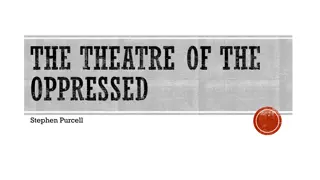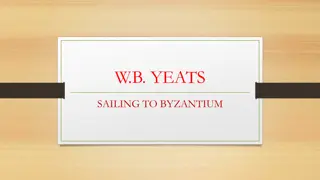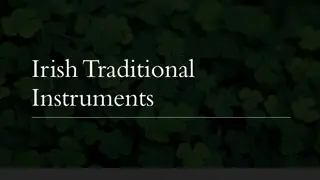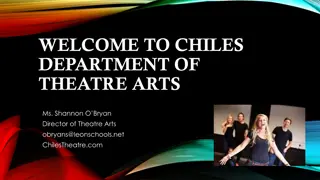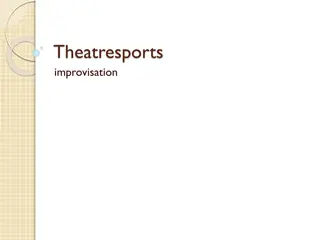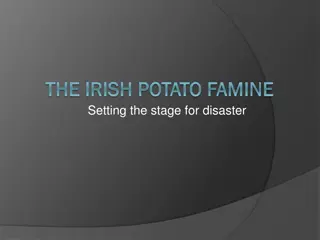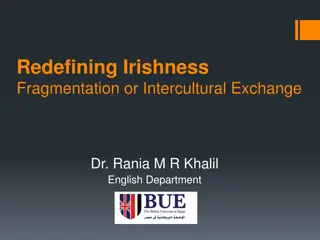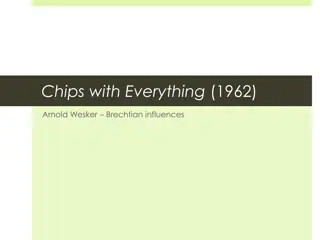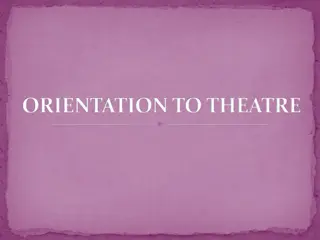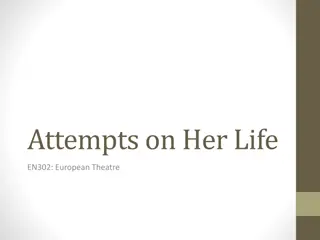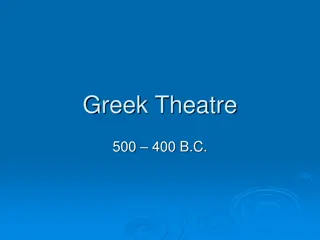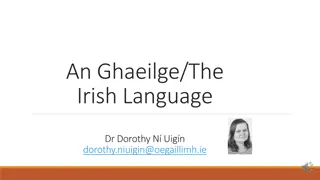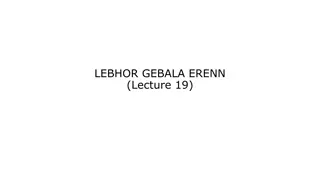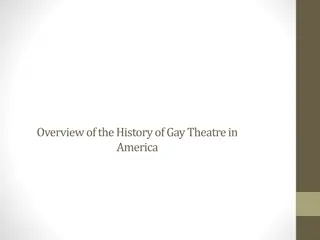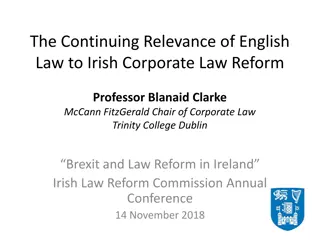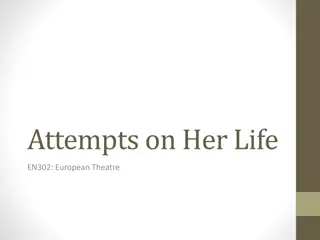History and Evolution of Irish Theatre
Irish theatre has a rich history intertwined with politics and cultural developments. From serving political purposes in the 17th century to nurturing indigenous writers and performers in the 20th century, Irish theatre has seen significant evolution. Dublin has been a key hub for theatrical productions, with theatres like The Gaiety, Theatre Royal, and Smock Alley contributing to Ireland's vibrant theatre scene. Despite challenges, Irish playwrights like William Congreve have left their mark on the global stage.
Download Presentation

Please find below an Image/Link to download the presentation.
The content on the website is provided AS IS for your information and personal use only. It may not be sold, licensed, or shared on other websites without obtaining consent from the author. Download presentation by click this link. If you encounter any issues during the download, it is possible that the publisher has removed the file from their server.
E N D
Presentation Transcript
IRISH THEATRE .The history of Irish administration in Dublin at the start of the 17th century. . In the early days of its history, theatrical productions in Ireland tended to serve the political purposes of the administration, but as more theatres opened and the popular audience grew, a more diverse range of entertainments were staged. . Many Dublin-based theatres developed links with their London equivalents and performers and productions from the British capital frequently found their way to the Irish stage. However, almost all Irish playwrights from William Congreve to George Bernard Shaw found it necessary to leave their native island to establish themselves. Irish theatre theatre begins with the rise of the English
IRISH THEATRE At the beginning of the 20th century, theatres and theatre companies dedicated to the staging of Irish plays and the development of indigenous writers, directors and performers began to emerge. This allowed many of the most significant Irish dramatists to learn their trade and establish their reputations in Ireland rather than in Great Britain or the United States.
IRISH THEATRE/ HISTORY The The Gaiety retains several Victorian era features and remains Ireland's longest- established, continuously producing public theatre. It is specialist in operatic and musical productions. The The Theatre Theatre Royal, Royal, Waterford Waterford dates to 1876, but retains some structural material from the 1785 theatre building which preceded it, and is considered Ireland's oldest continually operating theatre. The The Smock Smock Alley Alley Theatre Theatre was converted, in 2012, from an early 19th century church building which incorporated fabric from the 18th century theatre which preceded it, and is built on the foundations of the first Theatre Royal from 1662. It is thus often referred to as Ireland's "oldest new theatre" or "newest old theatre . The The Lord Lord Amiens Amiens Theatre Theatre was built as a private theatre wing of Aldborough House in 1795, and used as such until 1830. Gaiety Theatre Theatre dates to 1871, and despite multiple alterations it
IRISH THEATRE Although performances of plays on religious themes in Ireland from as early as the 14th century, the first well- documented instance of a theatrical production in Ireland is a 1601 staging of Gorboduc presented by Lord Mountjoy Lord Deputy of Ireland in the Great Hall in Dublin Castle. The play had been written by Thomas Sackville and Thomas Norton for the 1561/2 Christmas festivities at the Inner Temple in London and appears to have been selected because it was a story of a divided kingdom descending into anarchy that was applicable to the situation in Ireland at the time of the performance. there would appear to have been
IRISH THEATRE An early example of this trend is William Congreve, one of the most important writers for the late 18th London stage. Although born in Yorkshire, Congreve grew up in Ireland and studied with Jonathan Swift in Kilkenny and at Trinity College, Dublin. After graduating, Congreve moved to London to study law at the Temple and pursue a literary career. His first play, The Old Bachelor (1693) was sponsored by John Dryden, and he went on to write at least four more plays. The last of these, The Way of the World (1700) is the one Congreve work regularly revived on the modern stage.
IRISH THEATRE The 18th century saw the emergence of two major Irish dramatists, Oliver Goldsmith and Richard Brinsley Sheridan, who were two of the most successful playwrights on the London stage in the 18th century. Goldsmith published poetry, prose and two plays, The Good-Natur'd Man 1768 and She Stoops to Conquer 1773. Sheridan (1751 1816) was born in Dublin into a family with a strong literary and theatrical tradition. His mother was a writer and his father was manager of Smock Alley Theatre. His first play, The Rivals 1775. He went on to become the most significant London playwright of the late 18th century with plays like The School for Scandal and The Critic.
IRISH THEATRE After Sheridan, the next Irish dramatist of historical importance was Dion Boucicault (1820 1890). His first play was Legend of Devil's Dyke 1838 . Boucicault is widely regarded as the wittiest Irish dramatist between Sheridan and Oscar Wilde (1854 1900). Wilde was born in Dublin into a literary family and studied at Trinity College, where he had a brilliant career. Wilde's first stage success came with Lady Windermere's Fan (1892), which resulted in his becoming the most talked about dramatist in London. He followed this up with A Woman of No Importance (1893), An Ideal Husband (1895) and his most famous play The Importance of Being Earnest that same year. Wilde came to dominate late-Victorian era British theatre. His plays are noted for the lightness of their wit, but he also contrived to address some serious issues around sexual and class roles and identity, as he wrote himself 'treating the serious things lightly and the light things seriously'.
IRISH THEATRE Wilde's (1856 1950) was a very different kind of writer. He became active in socialist politics and became a member of the Fabian Society. His writing for the stage was influenced by Henrik Ibsen. Shaw was extremely prolific, and his collected writings filled 36 volumes. Many of his plays are now forgotten, but a number, including Major Barbara, Saint Joan (usually considered Pygmalion are still regularly performed. contemporary George Bernard Shaw his masterpiece) and
IRISH THEATRE The The Abbey A sea change in the history of the Irish theatre came with the establishment in Dublin in 1899 of the Irish Literary Theatre by W. B. Yeats, Lady Gregory, George Moore and Edward Martyn. This was followed by the Irish National Theatre Society, later to become the Abbey Theatre. the Abbey was to create a style that held a strong fascination for future Irish dramatists. Indeed, it could almost be said that the Abbey created the basic elements of a national theatrical style. Abbey and and after after
IRISH THEATRE The twentieth century saw a number of Irish playwrights come to prominence. Samuel Beckett is probably the most significant of these. Beckett had a long career as a novelist and poet before his first play, Waiting for Godot (1953) made him famous. This play, along with his second, Endgame, is one of the great works of absurdist theatre. The Lyric Theatre, founded in 1944 by Austin Clarke was based in the Abbey until 1951 and produced many of Clarke's own verse plays. "the the Absurd Absurd" refers to the conflict between the human tendency to seek inherent value and meaning in life and human inability to find any due to actual lack of any meaning or value. In this context absurd does not mean "logically impossible", but rather "humanly impossible".
IRISH LITERATURE Modern Irish literature is generally considered to have begun after the Irish Literary Renaissance, which spanned the years from 1885 to 1940 and is exemplified by the writings of William Butler Yeats, J. M. Synge, Padraic Colum, George Moore, and Sean O'Casey. While the writers of the Irish Literary Renaissance concerned themselves literature from its British counterpart by focusing on Celtic mythology, folklore, and the country's peasant culture, Irish literature since the advent of World War II concerns a wide variety of themes, styles, and subject matter. with distinguishing Irish
IRISH LITERATURE Ireland's neutrality during World War II evidences the country's attempts to distance itself politically from Great Britain; the period following the war was marked with violence associated with the Northern Irish strife between Protestants and Roman Catholics and the North's struggle for independence from England. This political strife has become the predominant subject matter for such diverse writers as Benedict Kiely, Seamus Heaney, and others who, while condemning the brutality perpetuated by the Irish Republican Army, independence from Great Britain and a reunited country. nevertheless advocate
IRISH LITERATURE Most Irish novels since World War II reveal their authors' preoccupation with political themes and the isolation and powerlessness felt by the country's inhabitants. The country's neutrality during the war often is blamed for the worldwide indifference to its literature following the war, which resulted in Irish writers producing what many critics perceive to be insular and parochial fiction. Many of these works contain stylistic similarities to the works of Irish novelist and short story writer James Joyce in their use of interior monologues consciousness narrative style. Among the most critically appreciated novelists are Benedict Kiely, John Banville, John McGahern, and Brian Moore. and stream-of-
A strange consideration lies at the heart of Irish writing in English. The strangeness resides in the fact that this literature is written in a language, English, which ground in Ireland from the beginning of the seventeenth century at the expense of Irish, the native language. steadily gained
IRISH LITERATURE Irish poetry since the death of Yeats in 1939 was initially dominated by Louis MacNeice and, later, John Montague, Patrick Kavanagh, and Thomas Kinsella. In the 1960s poets from Northern Ireland, including Derek Mahon, Paul Muldoon, and Nobel laureate Seamus Heaney, ignited another renaissance in Irish literature. These writers alternately depict the horrors of the violence in Ireland with writing of delicate beauty describing the rural Irish countryside. Irish drama since World War II often is considered to be dominated by the Absurdist works of Samuel Beckett, whose Waiting for Godot (1954) is considered the best example, and Brian Friel, whose play Translations (1981) attempts to debunk the stereotype of the ignorant Irish perpetuated by writers of the Irish Renaissance.
IRISH LITERATURE John Banville Long Lankin (novel) 1970 Nightspawn (novel) 1971 Birchwood (novel) 1973 Copernicus (novel) 1976 Kepler (novel) 1981 The Newton Letter (novel) 1983 Mephisto (novel) 1986 Samuel Beckett Molloy (novel) 1950 Malone Dies (novel) 1952 Waiting for Godot (drama) 1954 The Unnameable (novel) 1955 Endgame (drama) 1956 Krapp's Last Tape (drama) 1958 Radio II (drama) 1960 Happy Days (drama) 1961 Ghost Trio III (drama) 1976 Brendan Behan The Quare Fellow (drama) 1956 The Hostage (drama) 1958 Borstal Boy (novel) 1961 Maeve Binchy Light a Penny Candle (poetry) 1982 Echoes (novel) 1985 Elizabeth Bowen The Hotel (novel) 1927 The Last September (novel) 1929
IRISH LITERATURE Friends and Relations (novel) 1931 To the North (novel) 1932 The Death of the Heart (novel) 1935 The House in Paris (novel) 1935 The Heat of the Day (novel) 1949 A World of Love (novel) 1955 The Little Girls (novel) 1964 Eva Trout (novel) 1968 The Collected Stories of Elizabeth Bowen (short stories) 1981 John Boyd The Flats (drama) 1971 Clare Boylan Holy Pictures (novel) 1983 Ciaran Carson The Irish for No (poetry) 1987 Austin Clarke Pilgrimage (poetry) 1929 Collected Poems (poetry) 1936 Night and Morning (poetry) 1938 Ancient Lights (poetry) 1955 Later Poems (poetry) 1961 Flight to Africa (poetry) 1963 Mnemosyne Lay in Dust (poetry) 1966 Old-fashioned Pilgrimage (poetry) 1967
IRISH LITERATURE The Echo at Coole (poetry) 1968 Collected Poems (poetry) 1974 Anthony Cronin The Life of Riley (novel) 1964 Dead as Doornails (autobiography) 1976 Identity Papers (novel) 1979 Denis Devlin Lugh Derg and Other Poems (poetry) 1946 Collected Poems (poetry) 1963 Eilis Dillon Across the Bitter Sea (novel) 1973 Blood Relations (novel) 1977 Paul Durcan The Selected Paul Durcan (poetry) 1988 Padraic Fallon Collected Poems (poetry) 1990 Bernard Farrell I Do Not Like Thee, Dr. Fell (drama) 1979 Canaries (novel) 1980 All in Favour Said No! (drama) 1981 All the Way Back (drama) 1985 Say Cheese! (drama) 1987
KATHLEEN NI KATHLEEN NI HOULIHAN HOULIHAN Kathleen Kathleen Ni Ni Houlihan of Irish nationalism found in literature and art, sometimes representing woman. The figure of Kathleen Ni Houlihan has also been invoked in nationalist Irish politics. the Poor Poor Old Old Woman Woman, and similar appellations. Kathleen Ni Houlihan is generally depicted as an old woman who needs the help of young Irish men willing to fight and die to free Ireland from colonial rule, usually resulting in the young men becoming martyrs for this cause. Houlihan is a mythical symbol and emblem Ireland as a personified
KATHLEEN NI KATHLEEN NI HOULIHAN HOULIHAN As a literary figure, Kathleen Ni Houlihan was perhaps most famously used by William Butler Yeats and Lady Augusta Gregory in their play Cathleen N Houlihan. Other authors that have used Kathleen Ni Houlihan in some way include Se n O'Casey (especially in The Shadow of the Gunman) and James Joyce . Kathleen Ni Houlihan is generally portrayed as an old woman without a home. Frequently it is hinted that this is because she has been dispossessed of her home which comprised a farmhouse and "four green fields" (symbolising the four provinces of Ireland). In Yeats and Gregory's Cathleen N Houlihan (1902), she arrives at an Irish family's home as they are making preparations for the marriage of their oldest son. In Yeats and Gregory's play, Kathleen Ni Houlihan tells the family her sad tale, interspersed with songs about famous Irish heroes that had given their life for her. She ultimately lures the young groom away to join in the failed Irish Rebellion of 1798 against the British during the French Revolutionary Wars. After the groom makes his decision and leaves, one character notes that the old woman has become a beautiful young woman with the walk of a queen. Yeats and Gregory's treatment of Kathleen Ni Houlihan is fairly typical of this myth. The groom's choice and eventual death in the failed rebellion rejuvenates Kathleen Ni Houlihan to some degree.
KATHLEEN NI KATHLEEN NI HOULIHAN HOULIHAN the Kathleen Ni Houlihan myth represents the view that the blood sacrifice of heroes is needed to free and redeem Ireland. At the same time, these heroic sacrificial martyrs are rewarded by being "remembered for ever . The figure of Kathleen Ni Houlihan has appeared in several folk songs and poems. Ethna Carbery's "The Passing of the Gael" (1906), which was a sentimental treatment of the Irish diaspora during the 19th century suggested that Irish emigrants homeland. Carbery refers to Kathleen Ni Houlihan by name as the personification of Ireland that the emigrants miss. longed for their
KATHLEEN NI KATHLEEN NI HOULIHAN This was a play written in 1902 by William Butler Yeats and Lady Gregory and is filled with symbolism and focuses on men sacrificing their lives for Irish independence. Cathleen Ni Houlihan represents Ireland and she goes to a home where there is about to be a marriage and convinces the future groom, Michael, to give up the wedding and go fight. Michael to choose his country over his bride, Cathleen Ni Houlihan admits that there will be many deaths saying that, They that have red cheeks will have pale cheeks for my sake, and for all that, they will think they are well paid . Death is common during the time around the rising, but becoming a martyr is somethings that is admirable, so oftentimes people welcomed death so they could create themselves a heroic memory. remembered forever, which is why this theme is so ingrained into this play. It would be possible to convince men to go out to fight for their country. This play is about Irish Independence, but there are themes of martyrdom in other works, like the musical about American Independence, Hamilton and 1776. HOULIHAN When she is trying to convince The martyrs would be
KATHLEEN NI KATHLEEN NI HOULIHAN HOULIHAN This is such a simple play that contains many symbols and has the goal of convincing men to fight for Ireland. While this play was written about the rising of 1798, it was meant to inspire people for the 1916 Rising. Throughout the whole play, there is constant reference to memory and its influence on the public. This men that died while fighting for Ireland were considered heroes, which is why memory and martyrdom were such important themes that are incorporated into works about revolution. Cathleen Ni Houlihan says, They shall be They shall be They shall be The people shall hear When people are passionate about something, they are likely to dedicate their lives to it, and in the case of revolution, it might cost them their lives. Memory is valued, and many men during times of revolution from Britain wanted to be remembered as a hero. remembered alive speaking for ever, ever, ever, ever. for for them for


